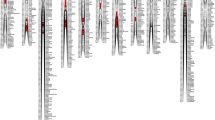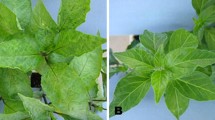Abstract
A simple procedure was developed to convertLathyrus sativus defence-related expressed sequence tags (ESTs) into mappable genetic markers by using PCR. Twenty-nine STS primer pairs were generated on the basis of sequence information from anL. sativus cDNA library. These primers were used to screen for polymorphisms between 2L. sativus accessions, ATC 80878 and ATC 80407, resistant and susceptible, respectively, toMycosphaerella pinodes infection. All 29 primer pairs amplified PCR products in both accessions, 11 of which amplified multiple RAPD-like products. The remaining 18 primer pairs amplified single monomorphic products. Following cloning, sequencing, and database searches, 17 of 18 PCR products were confirmed to have amplified the targeted genome region. Ten of these 17 STS primer pairs revealed polymorphisms between ATC 80878 and ATC 80407 when PCR products were digested with a range of restriction endonucleases. These results suggest that the STS-based PCR analysis will be useful for generating informative molecular markers inL. sativus for future genome mapping experiments.
Similar content being viewed by others
Abbreviations
- CAB:
-
chlorophyll a/b binding
- CAPS:
-
cleaved amplified polymorphic sequence
- EST:
-
expressed sequence tag
- SSR:
-
simple sequence repeat
- STS:
-
sequence-tagged sites
References
Altschul S, Madden T, Schaffer A, Zhang J, Zhang Z, Miller W, and Lipman D (1997) Gapped BLAST and PSI-BLAST: a new generation of protein database search programs. Nucl Acids Res 25: 3389–3402.
Campbell CG, Mehra RB, Agrawal SK, Chen YZ, El-Ali AMA, Khawaja HIT, Yadav CR, Toy J, and Araya WA (1994) Current status and future strategy in greeding grass pea (Lathyrus sativus). Euphytica 73: 167–175.
Cato SA, Gardner RC, Kent J, and Richardson TE (2001) A rapid PCR-based method for genetically mapping ESTs. Theor Appl Genet 102: 296–306.
Genetics Computer Group Inc. (1998) Oxford Molecular Group Inc., www.gcg.com
Gilpin BJ, McCallum JA, Frew TJ, and Timmerman-Vaughan GM (1997) A linkage map of pea (Pisum sativum L.) genome containing cloned sequences of known function and expressed sequence tags (ESTs) Theor Appl Genet 95: 1289–1299.
Gurung AM, Pang ECK, and Taylor PWJ (2002) Examination ofPisum andLathyrus species as sources of ascochyta blight resistance for field pea (Pisum sativum). Australas Plant Pathol 31: 41–45.
Iwata H, Ujino-Ihara T, Yoshimura K, Nagasaka K, Mukai Y, and Tsumura Y (2001) Cleaved amplified polymorphic sequence markers in sugi,Cryptomeria japonica D. Don, and their locations on a linkage map. Theor Appl Genet 103: 881–895.
Lyons LA, Laughin TF, Copeland NG, Jenkins NA, Womack JE, and Obrien SJ (1997) Comparative anchor tagged sequences (CATS) for intergratice mapping of mammalian genomes. Natural Genetics 15: 47–56.
Mano Y, Sayed-Tabatabaci BE, Graner A, Blake T, Takaiwa F, Oka S, and Komatsuda T (1999) Map construction of sequenced-tagged sites (STSs) in barley, (Hordeum vulgare L.). Theor Appl Genet 98: 937–046.
Olson M, Hood L, Cantor C, and Doststein D (1989) A common language for physical mapping of the human genome. Science 245: 1434–1435.
Rozen S and Skaletsky HJ (1998) Primer 3. 22 Sept. 1998. 24 Jan. 2004 <http:www. genome.wi.mit.edu/genome_software/other/primer3.html>.
Skiba B (2003) Mapping genes controlling resistance to ascochyta blight (Mycosphaerella pinodes) in a grasspea (Lathyrus sativas). PhD thesis, RMIT University.
Taylor PWJ, Fraser TA, Ko HL, and Henry RJ (1995) RAPD analysis of sugarcane during tissue culture. In: Terzi RCM and Falavigna A (eds), Current Issues in Plant Molecular and Cellular Biology, pp. 241–246, Kluwer Academic, Dordrecht, Boston, London.
Tsumura Y, Suyama Y, Yoshimura K, Shirato N, and Mukai Y (1997) Sequence-tagged-sites (STSs) of cDNA clones ofCryptomeria japonica and their evaluation as molecular markers in conifers. Theor Appl Genet 94: 764–772.
Vos P, Hogers R, Bleeker M, Reijans M, Van De Lee T, Hornes M, Frijters A, Pot J, Peleman J, Kuiper M, and Zabeau M (1995) AFPL: a new techniques for DNA fingerprinting. Nucl Acids Res 23: 4407–4414.
Weimer JL (1947) Resistance ofLathyrus spp. andPisum spp. toAscochyta pinodella andMycosphaerella pinodes. J Agric Res 75: 181–190.
Williams JGK, Kubelik AR, Livak KJ, Rafalski JA, and Tingley S (1990) DNA polymorphisms amplified by arbitrary primers are useful as genetic markers. Nucl Acids Res 18: 6531–6535.
Author information
Authors and Affiliations
Rights and permissions
About this article
Cite this article
Skiba, B., Ford, R. & Pang, E.C.K. Amplification and detection of polymorphic sequence-tagged sites inLathyrus sativus . Plant Mol Biol Rep 21, 391–404 (2003). https://doi.org/10.1007/BF02772588
Published:
Issue Date:
DOI: https://doi.org/10.1007/BF02772588




